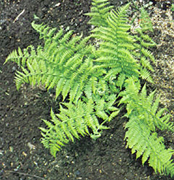

Common Names: Northern
Lady Fern
Genus: Athyrium
Species: felix-femina
Parts Used: the leaves are used for decoration

You may have Lady fern in your own house. Many people use it to decorate their homes. You may see it hanging or potted. People in Victorian times were crazy about Lady fern. However, Lady fern is not only found in the house. It also grows in the wild, especially in deciduous forests and the taiga of North America and Eurasia.
Lady Fern is a deciduous, perennial fern about 24 to 36 inches tall. Its light green, lacy leaves are about 24 to 30" long and 6 to 9" wide and tapered at both ends. The fronds are cut twice and
grow from a central base. The J-shaped spore casings, or sori, grow on the underside of the leaf.In the wild, Lady ferns can be found growing in meadows, open thickets, moist woods, and along stream beds. They also grow in the cracks of rocks. In the taiga it usually grows in the understory of white spruce, black spruce, Douglas-fir and western hemlock. Lady ferns prefer shaded areas.
Many Lady ferns will grow in a group in the shape of a circle. As they grow farther and farther outwards, the centers die away, leaving a ring of Lady Ferns. Lady ferns reproduce by thick, scaly rhizomes and spores. They grow in most semi-shaded areas.
Grizzly bears like to eat Lady ferns as a major food source. Elk will also eat it also. Native Americans had many uses for Lady ferns. They used lady ferns for drying berries on, and covering food. The young shoots, or fiddleheads, were cooked, baked or eaten raw. Tea was made from the leaves to help urination and to stop breast pain caused by childbirth. The tea was also used to ease labour pains. Roots were dried and ground into a dust to help heal wounds. Oil from the roots of Lady ferns has been used since the 1st century AD to get rid of worms. An overdose could cause weakness, coma, and often blindness.
Lady ferns are a dominant plant in the understory of the taiga, and will cover the forest floor. It is not an endangered plant.
2002
Bibliography:
"Lady Fern", http://members.eb.com, (6/18/00)
"Lady Fern", http://www.rook.org/earl/bwca/nature/ferns/athyriumfil.html
"Athyrium filix-famina", http://www.fs.fed.us/database/feis/plants/fern/athfil/
Athyrium filix-famina &endash; Lady Fern", http://www.borealforest.org/ferns/fern1.htm